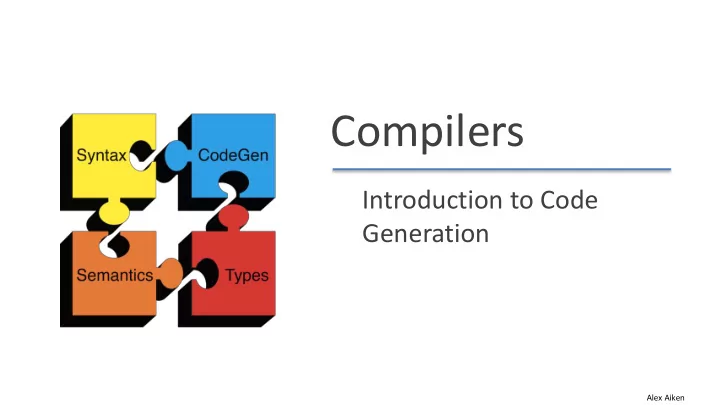

Compilers Introduction to Code Generation Alex Aiken
Code Generation • We focus on generating code for a stack machine with accumulator • We want to run the resulting code on a real machine – e.g., the MIPS processor (or simulator) • We simulate stack machine instructions using MIPS instructions and registers Alex Aiken
Code Generation • The accumulator is kept in MIPS register $a0 • The stack is kept in memory – The stack grows towards lower addresses – Standard convention on MIPS • The address of the next location on the stack is kept in MIPS register $sp – The top of the stack is at address $sp + 4 Alex Aiken
Code Generation MIPS architecture – Prototypical Reduced Instruction Set Computer (RISC) – Most operations use registers for operands & results – Use load & store instructions to use values in memory – 32 general purpose registers (32 bits each) • We use $sp, $a0 and $t1 (a temporary register) • Read the SPIM documentation for details Alex Aiken
Code Generation – lw reg 1 offset(reg 2 ) • Load 32-bit word from address reg 2 + offset into reg 1 – add reg 1 reg 2 reg 3 • reg 1 reg 2 + reg 3 – sw reg 1 offset(reg 2 ) • Store 32-bit word in reg 1 at address reg 2 + offset – addiu reg 1 reg 2 imm • reg 1 reg 2 + imm • “u” means overflow is not checked – li reg imm • reg imm Alex Aiken
Code Generation The stack-machine code for 7 + 5 in MIPS: acc 7 li $a0 7 push acc sw $a0 0($sp) addiu $sp $sp -4 acc 5 li $a0 5 acc acc + top_of_stack lw $t1 4($sp) add $a0 $a0 $t1 pop addiu $sp $sp 4 Alex Aiken
Recommend
More recommend